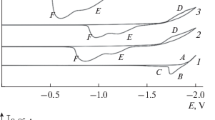Abstract
The effects of the electrolyte composition, deposition potential, temperature, and the salt-solvent cation on the oxygen factor (the [O]/[U] atomic ratio) of uranium oxides obtained by potentiostatic electrolysis of molybdate melts are studied. It is shown that the oxygen factor of the cathodic product increases with the melt temperature. The shift of the deposition potential toward more electronegative values, an increase in the Mo2O2− 7 ion concentration, and a decrease in the UO2MoO4 concentration favor the cathodic formation of uranium oxides with lower oxygen factors. All other conditions being the same, the oxygen factor decreases with increasing the salt-solvent cation radius. The observed anomalous behavior of the Li2MoO4-based electrolytes can be caused by a lower activity in the melts of the O2− anions that are capable of forming stable complexes Li3O+ with lithium cations. The obtained results can be reasonably explained in terms of the model of ionic composition of the uranyl-containing tungstate melts, which is based on the concept of involvement of the uranyl ions in the complexes’ formation and stepwise solvolysis.
Similar content being viewed by others
References
Afonichkin, V.K., Komarov, V.E., and Vakarin, S.V., Elektrokhimiya, 1993, vol. 29, p. 1356.
Afonichkin, V.K., Komarov, V.E., Khrustova, L.G., and Vakarin, S.V., Radiokhimiya, 2001, vol. 43, p. 224.
Mokhosoev, M.V., Alekseev, F.P., and Lutsyk, V.I., Diagrammy sostoyaniya molibdatnykh i vol’framatnykh sistem (Phase Equilibrium Diagrams for Molybdates and Tungstates), Novosibirsk: Nauka, 1978.
Nomure, Y., Kamegashira, N., and Naito, K., J. Cryst. Growth, 1981, vol. 52, p. 279.
Kaliev, K.A., Baraboshkin, A.N., and Zlokazov, V.A., Tr. Inst. Elektrokhim., Ural. Nauchn. Tsentr Akad. Nauk SSSR, 1979, no. 28, p. 39.
Drobasheva, T.I., Zueva, V.P., and Spitsyn, V.I., Zh. Neorg. Khim., 1980, vol. 25, p. 1694.
Dion, C. and Noel, A., Bull. Soc. Chim. Fr., 1982, p. 1188.
Dion, C. and Noel, A., Bull. Soc. Chim. Fr., 1983, p. 1257.
Afonichkin, V.K., Komarov, V.E., and Khrustova, L.G., Abstracts of Papers, IV Ross. konf. po radiokhimii (IV All-Russian Conf. on Radiochemistry), 2003, Ozersk, p. 133.
Zakhar’yash, S.M., Extended Abstract of Cand. Sci. Dissertation, Inst. Elektrokhim., Ural Nauchn. Tsentr, Akad. Nauk SSSR, 1982.
Smirnov, M.V., Elektrodnye potentsialy v rasplavlennykh khoridakh (Electrode Potentials in Molten Chlorides), Moscow: Nauka, 1973.
Smolenskii, V.V., Bove, A.L., and Martem’yanova, Z.S., Elektrokhimiya, 1994, vol. 34, p. 781.
Author information
Authors and Affiliations
Corresponding author
Additional information
Original Russian Text © V.K. Afonichkin, V.E. Komarov, L.G. Khrustova, A.L. Bove, 2006, published in Elektrokhimiya, 2006, Vol. 42, No. 6, pp. 698–704.
Rights and permissions
About this article
Cite this article
Afonichkin, V.K., Komarov, V.E., Khrustova, L.G. et al. Effect of cationic composition of electrolytes based on the M2MoO4-M2Mo2O7-UO2MoO4 (M = Li, Na, K, Cs) system on the oxygen factor of the uranium electrolytic oxides. Russ J Electrochem 42, 626–631 (2006). https://doi.org/10.1134/S102319350606005X
Received:
Accepted:
Issue Date:
DOI: https://doi.org/10.1134/S102319350606005X



